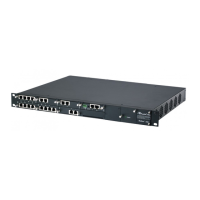SIP User's Manual 702 Document #: LTRT-83310
Mediant 600 & Mediant 1000
Parameter Description
the QSIGTunnelingMode parameter.
Tunneling according to ECMA-355 is applicable to all ISDN
variants (in addition to the QSIG protocol).
For more information on QSIG tunneling, see 'QSIG
Tunneling' on page 241.
[QSIGTunnelingMode]
Defines the format of encapsulated QSIG message data in the
SIP message MIME body.
[0] = ASCII presentation of Q.931 QSIG message (default).
[1] = Binary encoding of Q.931 QSIG message (according
to ECMA-355, RFC 3204, and RFC 2025).
Note: This parameter is applicable only if the QSIG Tunneling
feature is enabled (using the EnableQSIGTunneling
parameter).
Web: Enable Hold to ISDN
EMS: Enable Hold 2 ISDN
[EnableHold2ISDN]
Enables SIP-to-ISDN interworking of the Hold/Retrieve
supplementary service.
[0] Disable (default)
[1] Enable
Notes:
This parameter is applicable to Euro ISDN variants - from
TE (user) to NT (network).
This parameter is applicable also to QSIG BRI.
If the parameter is disabled, the device plays a Held tone to
the Tel side when a SIP request with 0.0.0.0 or "inactive" in
SDP is received. An appropriate CPT file with the Held tone
should be used.
EMS: Duplicate Q931 Buff Mode
[ISDNDuplicateQ931BuffMode]
Determines the activation/deactivation of delivering raw Q.931
messages.
[0] = ISDN messages aren't duplicated (default).
[128] = All ISDN messages are duplicated.
Note: For this parameter to take effect, a device reset is
required.
Web/EMS: ISDN SubAddress
Format
[ISDNSubAddressFormat]
Determines the encoding format of the SIP Tel URI parameter
'isub', which carries the encoding type of ISDN subaddresses.
This is used to identify different remote ISDN entities under the
same phone number (ISDN Calling and Called numbers) for
interworking between ISDN and SIP networks.
[0] = ASCII - IA5 format that allows up to 20 digits. Indicates
that the 'isub' parameter value needs to be encoded using
ASCII characters (default)
[1] = BCD (Binary Coded Decimal) - allows up to 40
characters (digits and letters). Indicates that the 'isub'
parameter value needs to be encoded using BCD when
translated to an ISDN message.
[2] = User Specified
For IP-to-Tel calls, if the incoming SIP INVITE message
includes subaddress values in the 'isub' parameter for the
Called Number (in the Request-URI) and/or the Calling Number
(in the From header), these values are mapped to the outgoing
ISDN Setup message.
If the incoming ISDN Setup message includes 'subaddress'
values for the Called Number and/or the Calling Number, these

